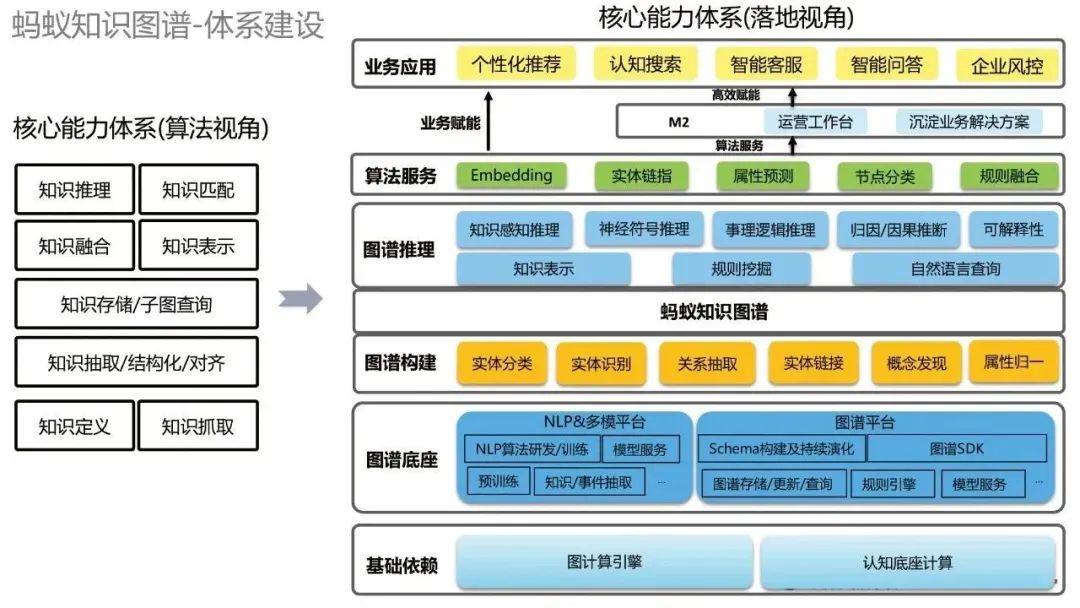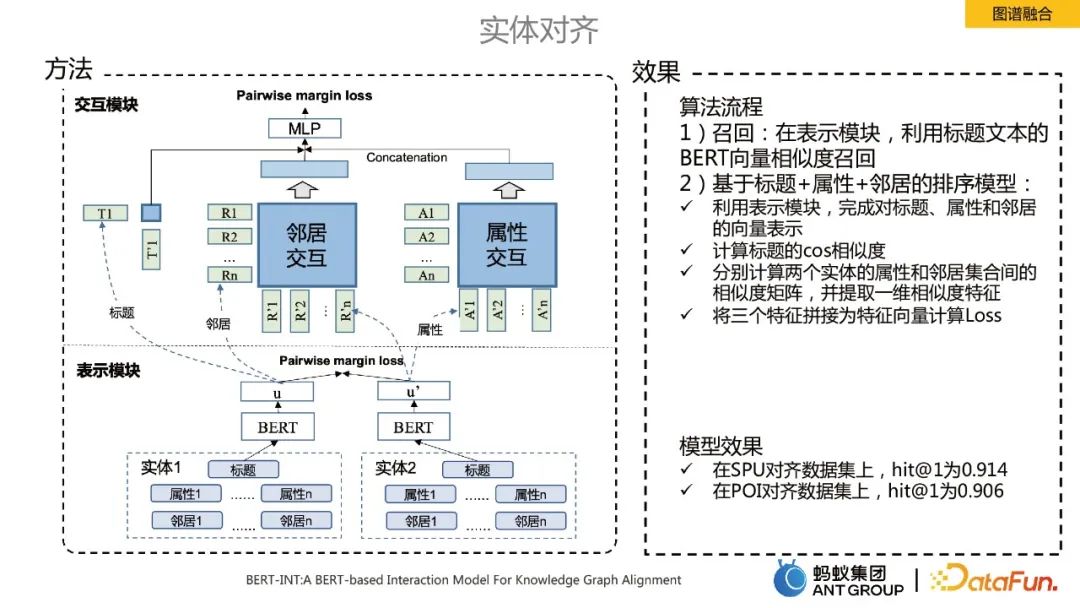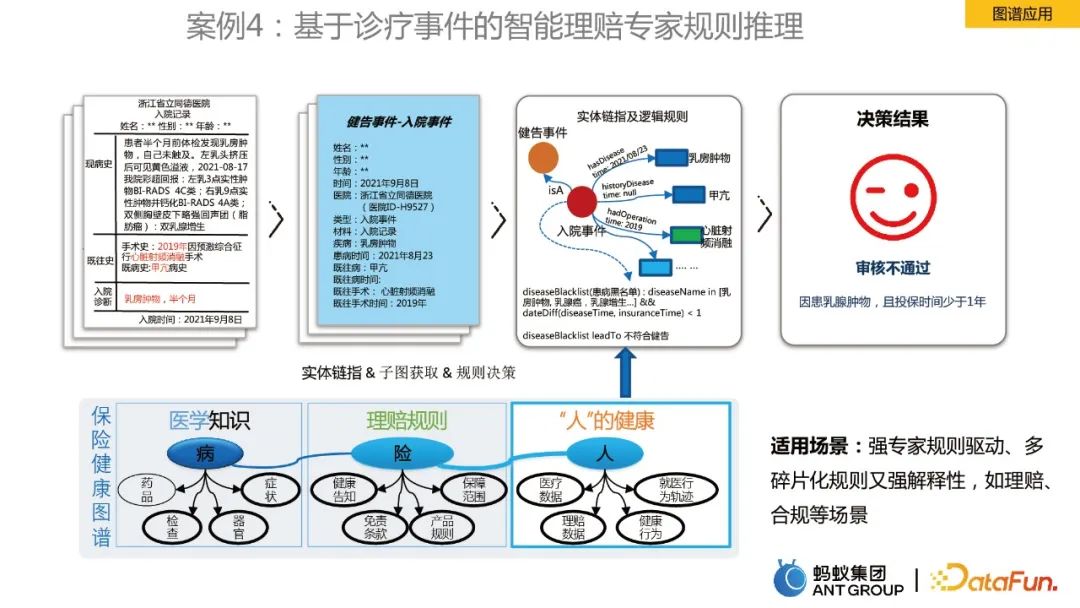

First introduce some basic concepts of the knowledge graph.

The knowledge graph aims to use graph structures to model, identify and infer the relationships between things. Complex relationships and accumulated domain knowledge are important cornerstones for realizing cognitive intelligence and have been widely used in many fields such as search engines, intelligent question answering, language semantic understanding, and big data decision analysis.
Knowledge graph models both the semantic relationship and the structural relationship between data. Combined with deep learning technology, the two relationships can be better integrated and represented.

We want to build a knowledge graph mainly from the following two points: on the one hand It is the background characteristics of the data source of the ants themselves, and on the other hand, it is the benefits that the knowledge graph can bring.
[1] The data sources themselves are diverse and heterogeneous, lacking a unified knowledge understanding system.
[2] Knowledge graph can bring many benefits, including:

In the process of building various business knowledge graphs , we have precipitated a set of general construction paradigms for ant knowledge graphs, which are mainly divided into the following five parts:

After we have a common construction paradigm, we need to carry out systematic construction. Look at the systematic construction of the Ant Knowledge Graph from two perspectives. First, from an algorithmic perspective, there are various algorithmic capabilities, such as knowledge reasoning, knowledge matching, etc. From the perspective of implementation, from bottom to top, the lowest basic dependencies include graph computing engine and cognitive base computing; above it is the graph base, including NLP & multi-modal platform and graph platform; above it are various graph construction technologies, Based on this, we can build the ant knowledge graph; on the basis of the knowledge graph, we can do some graph reasoning; further up, we provide some general algorithm capabilities; at the top are business applications.
Next, we will share some of Ant Group’s core capabilities in building knowledge graphs, including graph construction, graph fusion, and graph cognition.

The graph construction process mainly includes six steps:

In building a knowledge graph, it is necessary to classify the input entities. In the ant scenario, it is a large-scale multi-label classification task. In order to integrate expert knowledge for entity classification, the following three optimizations are mainly made:

#On the basis of entity recognition, from word to edge Starting from the graph structure, the model learns reasonable weighting of the connected edges and reduces the weight of the noisy word connected edges. Two modules of boundary contrast learning and semantic contrast learning are proposed:

Our annotation samples are very large in domain issues If it is less, you will face a few-shot or zero-shot scenario. In this case, the core idea of relation extraction is to introduce an external knowledge base. In order to solve the problem of performance degradation caused by different semantic spaces, a reasoning module based on logical rules is designed. ;In order to solve the rote learning problem caused by entity type matching, a subtle difference perception module is designed.
Graph fusion refers to the fusion of information between graphs in different business fields.

Benefits of graph fusion:

A core technical point in the knowledge graph fusion process is entity alignment. Here we use the SOTA algorithm BERT-INT, which mainly includes two modules, one is the presentation module and the other is the interaction module.
The implementation process of the algorithm mainly includes recall and sorting:
Recall: In the presentation module, the title text is used BERT vector similarity recall.
Sorting model based on title attribute neighbors: ü Use the representation module to complete the vector representation of titles, attributes and neighbors:

This part mainly introduces the internal knowledge representation learning of ants frame.
Ant proposed a knowledge representation learning based on the Encoder-Decoder framework. Among them, Encoder is some graph neural learning methods, and Decoder is some knowledge representation learning, such as link prediction. This representation learning framework can self-supervise the production of universal entity/relationship Embeddings, which has several benefits: 1) Embedding Size is much smaller than the original feature space, reducing storage costs; 2) Low-dimensional vectors are denser, effectively alleviating the problem of data sparseness. ; 3) Learning in the same vector space makes the fusion of heterogeneous data from multiple sources more natural; 4) Embedding has certain universality and is convenient for downstream business use.
Next, I will share some typical application cases of knowledge graph in Ant Group.
Before introducing specific cases, let’s first introduce several modes of scenario application of the Ant Knowledge Graph, including knowledge acquisition, Knowledge management and reasoning, and knowledge services. As shown below.


The business scenario is to download the content of the mini program in Alipay’s main search. The business pain points to be solved are:
#The solution is to build a merchant knowledge graph. Combined with the product relationship of the merchant map, a structured understanding of the user query product level is achieved.

This case is for real-time prediction of user intent for homepage recommendations , AlipayKG was built, and the framework is shown in the figure above. Related work was also published on the top conference www 2023. You can refer to the paper for further understanding.

#This scenario is a scenario of consumer coupon recommendation, and the business faces The pain points are:
#In order to solve the above problems, we designed a deep vector recall algorithm that integrates dynamic graph representation. Because we found that the behavior of user consumption coupons is cyclical, a static single edge cannot model this cyclical behavior. To this end, we first constructed a dynamic graph, and then used the team's self-developed dynamic graph algorithm to learn the Embedding representation. After obtaining the representation, we put it into the twin tower model for vector recall.

The last case is about graph rule reasoning. Taking the medical insurance health map as an example, it includes medical knowledge, claims rules, and "person" health information, which are linked to entities and coupled with logical rules as the basis for decision-making. Through the map, the efficiency of expert claims settlement has been improved.
Finally, let’s briefly discuss the opportunities of knowledge graphs in the context of the current rapid development of large models.

Knowledge graph and large model each have their own advantages and disadvantages. The main advantages of large model are It has the advantages of general knowledge modeling and universality, and the shortcomings of large models can be made up for by the advantages of knowledge graphs. The advantages of the map include high accuracy and strong interpretability. Large models and knowledge graphs can influence each other.
There are usually three routes to the integration of graphs and large models. One is to use knowledge graphs to enhance large models; the second is to use large models to enhance knowledge graphs; the third is to use knowledge graphs to enhance large models. The large model and the knowledge graph work together and complement each other. The large model can be considered as a parameterized knowledge base, and the knowledge graph can be considered as a displayed knowledge base.

In the process of knowledge graph construction, large models can be used for information extraction, knowledge modeling and relationship reasoning.

This work of DAMO Academy decomposes the information extraction problem It becomes two stages:

##Applying knowledge graph to large model mainly includes three aspects: Aspects:
Integrate the knowledge graph into the large model input. The knowledge graph can be used for data cleaning, or the knowledge graph can be used to directly perform formal splicing.
Integrate knowledge graph into large model training. For example, two tasks are trained at the same time. The knowledge graph can be used for knowledge representation tasks, and the large model can be used for pre-training of MLM, and the two are jointly modeled.
Inject knowledge graph into large model reasoning. First, two problems with large models can be solved. One is to use the knowledge graph as a priori constraints to avoid the "nonsense" of large models; the second is to solve the problem of timeliness of large models. On the other hand, based on knowledge graphs, interpretable solutions can be provided for large model generation.

Mainly includes two categories. One is the knowledge graph-enhanced question and answer system, which uses a large model to optimize the KBQA model; The other is information retrieval enhancement, similar to how LangChain, GopherCite, New Bing, etc. use large models to do knowledge base question and answer.
The knowledge-enhanced generative search Q&A system has the following advantages:

How to better interact and collaborate with knowledge graphs and large models Progress includes the following three directions:
The above is the detailed content of Jia Qianghuai: Construction and application of large-scale knowledge graph of ants. For more information, please follow other related articles on the PHP Chinese website!
 what is mysql index
what is mysql index
 What is highlighting in jquery
What is highlighting in jquery
 Ethereum browser blockchain query
Ethereum browser blockchain query
 How to retrieve Douyin flames after they are gone?
How to retrieve Douyin flames after they are gone?
 How to solve the problem of 400 bad request when the web page displays
How to solve the problem of 400 bad request when the web page displays
 Commonly used search tools
Commonly used search tools
 Free software for building websites
Free software for building websites
 What is the basic concept of artificial intelligence
What is the basic concept of artificial intelligence




